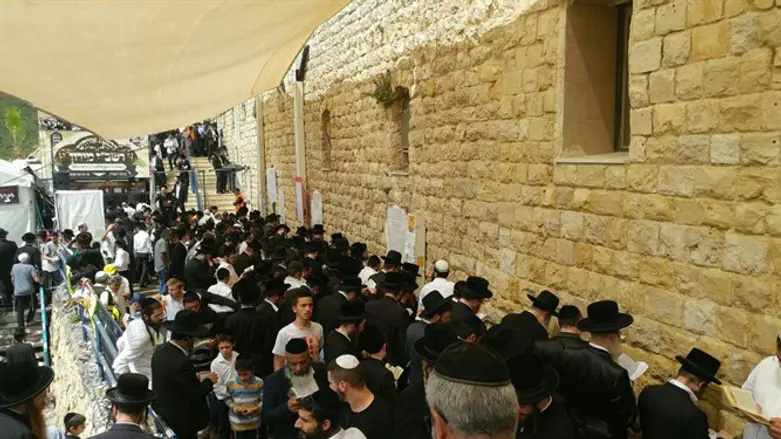
Members of the Knesset's Internal Affairs on Sunday toured the tomb of Zohar author Rabbi Shimon Bar Yochai (Rashbi) in Meron.
The purpose of the visit was to ensure that on Lag Ba'omer in 2018, the site would be better equipped for the tens of thousands of visitors expected to arrive.
Some 1,700,000 Israelis and tourists visit Rashbi's tomb throughout the year, with 400,000 of them arriving on Lag Ba'omer, the day of Rashbi's passing.
"This is the second most popular site in all of Israel, coming in right after the Western Wall," managers explained during the visit.
Other than Lag Ba'omer, which is also the busiest day for public transportation, popular days include the intermediate days of Passover and Sukkot, Saturday nights, and the day preceding the first day of each Hebrew month. At some of these times, the number of worshipers at the site can reach the thousands.
"It's obvious that the nearby roads and parking lots should be ready for the enormous quantity of visitors, but in fact there is only one narrow road leading to the site, and every time a bus stops to let up passengers, he delays all of those behind him," Committee members said. "The parking lots are small and improperly laid out. There are trees in them, and the variation in height makes these lots dangerous to use after dark."
"How can it be that Rashbi's tomb is not fit for so many visitors?" MK David (Dudu) Amsalem (Likud) asked. "This site has fallen between the cracks. I was told that the Religious Services Ministry was working on building a new road. They're supposed to deal with religious affairs, not with roads."
"I see these grandstands, and I'm scared of the safety hazards. A tiny bit of rain and sun, and they'll fall apart. No one is taking care of the equipment... We're not taking care of the parking lots like we should be."
Meron Council Secretary Mordechai Halperin said, "There is no doubt that we can enlarge the area without harming the existing agriculture, and especially the vineyards, which are well-known for their quality. It's simply a function of budget and investment."
"A train is also an option. When the train reaches the Hananya Junction, we can have shuttles going to and from Rashbi's tomb. That's a good solution for the long term, and it will solve the problem without forcing us to invest in expensive parking lots."
MK Menachem Moses (UTJ) told those present, "Three years ago, I was the haredi representative who said there should be no more public vehicles at the site, since they clog up the roads even before they reach the Golani Junction."
"Since then, only public transportation has entered the site. People demonstrated against me. But if they bring a few trains, will it really help eliminate the dangers of so many bonfires close together? The only reason nothing has happened yet is that Rashbi is protecting us. A four-land road is now one lane."
Merom Hagalil Regional Council Head Amit Sofer said the number of visitors to the site rises each year.
"What this means is that we need to create proper infrastructure: plumbing, garbage cans, electricity. The Council receives a small sum from the Interior Ministry. And we also have to deal with peddlers and parking lots. The Religious Services Ministry is pushing to gather resources, so that this holy site will be able to function the way it should and receive so many visitors."
"This statutory plan has been on and off for eight years, and there will almost certainly be many who oppose it."
During a meeting held in the Council afterwards, an urban building scheme was presented for the site which included a visitors and tourist center. Moses decisively refused the plan, saying, "Tourism and Rashbi's holiness do not go hand in hand. This plan will not happen."